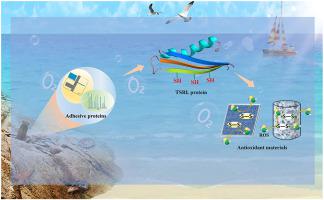Bioactive Materials ( IF 18.0 ) Pub Date : 2021-09-04 , DOI: 10.1016/j.bioactmat.2021.08.021 Lulu Wang 1, 2 , Xiaokang Zhang 1, 2 , Pingping Xu 1, 2 , Jicheng Yan 1, 2 , Yuzhong Zhang 1, 2, 3 , Hainan Su 3 , Chengjun Sun 2, 4 , Qiang Lu 5 , Weizhi Liu 1, 2

|
Antioxidant biomaterials have attracted much attention in various biomedical fields because of their effective inhibition and elimination of reactive oxygen species (ROS) in pathological tissues. However, the difficulty in ensuring biocompatibility, biodegradability and bioavailability of antioxidant materials has limited their further development. Novel bioavailable antioxidant materials that are derived from natural resources are urgently needed. Here, an integrated multi-omics method was applied to fabricate antioxidant biomaterials. A key cysteine-rich thrombospondin-1 type I repeat-like (TSRL) protein was efficiently discovered from among 1262 adhesive components and then used to create a recombinant protein with a yield of 500 mg L−1. The biocompatible TSRL protein was able to self-assemble into either a water-resistant coating through Ca2+-mediated coordination or redox-responsive hydrogels with tunable physical properties. The TSRL-based hydrogels showed stronger 1,1-diphenyl-2-picrylhydrazyl (DPPH) radical scavenging rates than glutathione (GSH) and ascorbic acid (Aa) and protected cells against external oxidative stress significantly more effectively. When topically applied to mice skin, TSRL alleviated epidermal hyperplasia and suppressed the degradation of collagen and elastic fibers caused by ultraviolet radiation B (UVB) irradiation, confirming that it enhanced antioxidant activity in vivo. This is the first study to successfully characterize natural antioxidant biomaterials created from marine invertebrate adhesives, and the findings indicate the excellent prospects of these biomaterials for great applications in tissue regeneration and cosmeceuticals.
中文翻译:

具有增强抗氧化活性的海葵高性能生物材料的探索
抗氧化生物材料因其有效抑制和消除病理组织中的活性氧(ROS)而在各个生物医学领域受到广泛关注。然而,抗氧化材料在确保生物相容性、生物降解性和生物利用度方面的困难限制了它们的进一步发展。迫切需要从自然资源中提取的新型生物可利用抗氧化材料。在这里,一种集成的多组学方法被应用于制造抗氧化生物材料。从 1262 种粘附成分中有效地发现了一种关键的富含半胱氨酸的血小板反应蛋白-1 I 型重复样 (TSRL) 蛋白,然后用于制造重组蛋白,产量为 500 mg L -1. 生物相容性 TSRL 蛋白能够通过 Ca 2+介导的配位或具有可调物理特性的氧化还原响应水凝胶自组装成防水涂层。基于 TSRL 的水凝胶显示出比谷胱甘肽 (GSH) 和抗坏血酸 (Aa) 更强的 1,1-二苯基-2-苦基肼 (DPPH) 自由基清除率,并且能更有效地保护细胞免受外部氧化应激。当局部应用于小鼠皮肤时,TSRL 减轻表皮增生并抑制紫外线辐射 B (UVB) 照射引起的胶原蛋白和弹性纤维的降解,证实它增强了体内抗氧化活性. 这是第一项成功表征由海洋无脊椎动物粘合剂制成的天然抗氧化生物材料的研究,研究结果表明这些生物材料在组织再生和药妆品方面的巨大应用前景广阔。









































 京公网安备 11010802027423号
京公网安备 11010802027423号